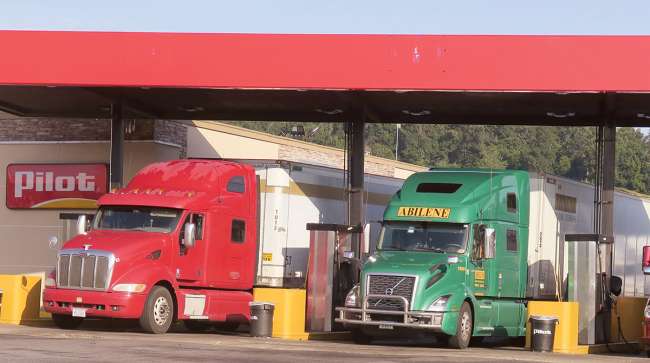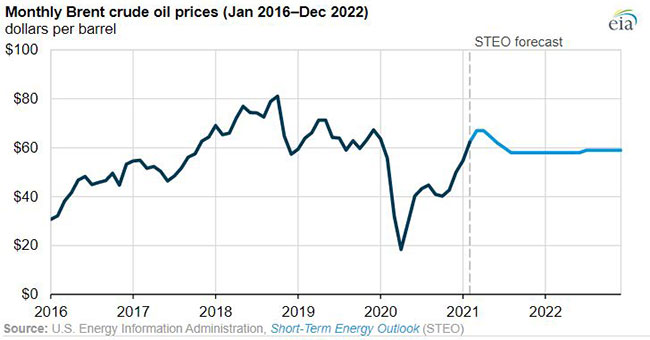Diesel Climbs 4.8¢ to $3.191 a Gallon

[Stay on top of transportation news: Get TTNews in your inbox.]
The national average price for a gallon of diesel rose 4.8 cents to $3.191 a gallon, according to data released by the Energy Information Administration on March 15.
This marks the 19th consecutive week in which the price of diesel increased. The price of trucking’s main fuel continued to rise, albeit at a markedly lower rate. This week’s price declined from a 7.1-cent rise last week, which followed gains of 9.7 cents and 9.9 cents, respectively, on Feb. 22 and March 1.
A gallon of diesel now costs 45.8 cents more than at this time in 2020.
Highlights
- The price of trucking’s main fuel continued to rise, albeit at a markedly lower rate. This week’s price declined from a 7.1-cent rise last week and increases of 9.7 cents and 9.9 cents, respectively on Feb. 22 and March 1.
- A gallon of diesel now costs 45.8 cents more than at this time in 2020.
- The Rocky Mountain area saw the largest weekly increase — 14.5 cents — of the 10 regions in EIA’s survey.
- Gasoline leapt by 8.2 cents per gallon, soaring to $2.853 on a national average.
The Rocky Mountain area saw the largest weekly increase — 14.5 cents — of the 10 regions in EIA’s survey. The smallest increase was in the Central Atlantic region, where diesel increased 2.6 cents per gallon to $3.292. Diesel in that region now costs 30.3 cents more than at this time in 2020, when the COVID-19 pandemic caused oil production to plunge domestically and internationally.
According to the Bureau of Labor Statistics, the price of crude petroleum imports fell nearly 63% in the first three months of 2020, making it the biggest sustained drop in oil prices since the government agency began keeping that statistic in 1992.
The price of unleaded gasoline increased by 8.2 cents per gallon, soaring to $2.853 on a national average.
Glen Kedzie, energy and environmental counsel for American Trucking Associations, told Transport Topics the collapse of oil prices last year has left producers nervous about pumping more oil because they fear an oversupply could cause prices to fall again.
U.S. On-Highway Diesel Fuel Prices

EIA.gov
“At least at this point, inventories are low and prices are increasing, and the oil producers are going to play it out and see where prices go,” Kedzie said. “It’s supply and demand; that’s the basic premise here. Now we see oil prices in the mid-$60-a-barrel range, and it’s a far cry from last year.”
Meanwhile, EIA, in its latest Short Term Energy Outlook released March 17, expects Brent crude oil prices will average $64 per barrel in the second quarter of the year, then fall to less than $60 a barrel through the end of 2022.
EIA said higher crude oil prices in March and what are expected in April resulted from lower production by members of the Organization of the Petroleum Exporting Countries and partner nations (known as OPEC Plus), as announced at the organization’s March 4 meeting.

“The speed of actual demand recovery, based on COVID-19 vaccination rates and the degree to which travel and employment conditions return to pre-COVID norms, remains an important uncertainty on the demand side,” the EIA report. “At the same time, the degree to which OPEC Plus production cuts will continue after April remains a source of uncertainty on the supply side, especially because increasing crude oil prices will encourage OPEC Plus participants to agree to production increases in later meetings or to relax compliance with the existing agreement. Finally, the responsiveness of U.S. tight oil production to higher oil prices is also uncertain.”
On U.S. oil trading markets, West Texas Intermediate is the preferred petroleum product and baseline for pricing. It is slightly “lighter” and “sweeter” than Brent crude. Also, WTI generally is slightly lower in price than Brent crude.
WTI is the oil used at most U.S. refineries to make gasoline, diesel and other fuels. On March 17, Brent crude was trading on the world market at nearly $68 a barrel, while WTI was slightly above $64 a barrel.
Meanwhile, a March 17 report from the International Energy Agency, which was formed in 1973-74 amid the oil price and supply shocks of that era, said global oil demand will take until 2023 to recover to pre-pandemic levels of 100 million barrels per day. But because of COVID-19, global gasoline demand is likely past its peak.
“Global oil demand, still reeling from the effects of the pandemic, is unlikely to catch up with its pre-COVID trajectory,” IEA’s annual report on energy consumption and production said. Oil demand will increase from the depths of the pandemic, but “there may be no return to ‘normal’ for the oil market in the post-COVID era,” the Paris-based agency said.
IEA said gasoline demand worldwide likely peaked in 2019, and it will decline as more nations insist on tighter environmental regulations. Too, several original equipment manufacturers have stated their plans to transition from petroleum-based, internal combustion engines to electric technology for their cars and trucks.
Want more news? Listen to today's daily briefing below or go here for more info:


